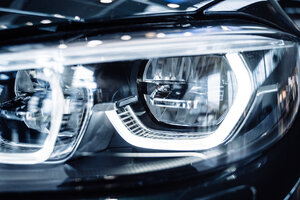Upgrade your vehicle lights wirelessly with Innoware’s XBB System

Image by teksomolika on Freepik
Swedish company Innoware Development has launched a vehicle smart lighting system, designed to enable the simple installation of aftermarket auxiliary lights. Consisting of an ‘XBB Dongle’ and ‘XBB PowerUnit’, the solution can be fitted without any modifications to the vehicle’s original electrical setup by using Bluetooth LE wireless connectivity provided by Nordic Semiconductor’s nRF52832 SoC.
Once the user has installed aftermarket lights to their vehicle, they are connected to the XBB PowerUnit which is in turn connected to the car’s battery. Meanwhile, the XBB Dongle is plugged into the vehicle’s OBD2 port. Both devices integrate the ISP1507-AX module from Insight SiP, which is based on Nordic’s nRF52832 SoC. The module provides Bluetooth LE connectivity between the XBB PowerUnit and the XBB Dongle, as well as between the dongle and the ‘XBB Configurator’ app on the user’s smartphone.
Personalised configuration
From the app the user can download vehicle specific settings or ‘recipes’ and configure preferred signals for controlling the lights through the vehicle’s existing controls. The app includes a dashboard to toggle the lights on and off, and provides statistics such as restarts and ignition time. Users can also update the system firmware via the app.
“This solution is designed for vehicle workshops or individuals who want an easy and efficient way to install auxiliary lights on their vehicle while minimising cable routing,” said Karl-Henrik Söderqvist, the CEO at Innoware Development. “It’s currently being used across Sweden, Norway, Finland, Denmark and Germany. Through the app, users can customise the installed system to their liking, without the need to cut any cables or penetrate the firewall between the engine bay and the cabin. This approach makes the installation safer, as it avoids tampering with the vehicle’s existing electrical system.”
Extended battery life
While the solution is powered by the vehicle’s battery, the ultra low power characteristics of the nRF52832 SoC ensure it does not drain large amounts of power when the vehicle is turned off. The XBB Dongle and XBB PowerUnit draw approximately 7.5 mA when the vehicle is turned off, below the 10 mA maximum parasitic current draw typically specified by vehicle manufacturers. The nRF52832 SoC has been engineered to minimise power consumption with features such as the 2.4 GHz radio’s 5.5 mA peak RX/TX currents and a fully-automatic power management system.
“Power consumption was a crucial factor in our decision to use the nRF52832 SoC and its energy efficiency significantly influenced our design,” said Söderqvist. “The SoC’s compatibility with the Zephyr RTOS, and the comprehensive documentation and technical assistance offered by Nordic were also major advantages during development.”
Comment on this article below or via X @IoTGN
